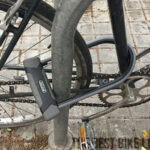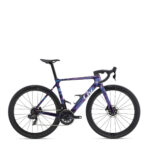Radio Flyer has been a beloved name in children’s toys for generations, synonymous with classic wagons and tricycles. Building on this legacy, their new line of kids’ pedal bikes, the “Flyer” series, aims to bring the same quality and appeal to a new generation of riders. These brightly colored bikes, available in 16″, 20″, and 24″ wheel sizes with robust aluminum frames, certainly look promising at first glance. But when it comes to choosing the best Radio Flyer Bike for your child, how do they truly perform against the competition? Our team of kid bike testers put these Radio Flyer pedal bikes through rigorous testing, evaluating everything from rider comfort to braking efficiency, to help you determine if a Flyer bike is the perfect fit for your family.
Radio Flyer Kids Pedal Bikes: An In-Depth Overview
The Radio Flyer “Flyer” pedal bike collection offers three distinct sizes to cater to different age groups and skill levels: 16″, 20″, and 24″ wheels. Each radio flyer bike in the Flyer series boasts a lightweight aluminum frame and comes in a vibrant palette of 5 colors.
The Flyer 16″ model is designed as a simple, single-speed bike equipped with a coaster brake, ideal for younger children just learning to ride. Stepping up in size and complexity, the Flyer 20″ and 24″ models feature dual handbrakes and a 7-speed gear system, providing more advanced control and versatility for older kids.
While the 24″ Flyer emerges as a strong contender in its category and price range, we express reservations about recommending the Flyer 16″ and Flyer 20″. Both of these smaller models present certain drawbacks that lead us to suggest exploring alternative bikes, potentially even more budget-friendly options, that might offer a better overall value.
Detailed Reviews of Each Radio Flyer Bike Size
Explore the Full Range of FLYER Kids Bikes
Radio Flyer FLYER 16: A Closer Look
MSRP: $199
SEAT HEIGHT: 18.8″ – 23.5″
WEIGHT: 20.4 lb (without training wheels)
BRAKES: Coaster brake
TRAINING WHEELS: Included
RECOMMENDATION: Recommended with price considerations
Key Considerations for the Flyer 16
The Radio Flyer Flyer 16 is undeniably a well-constructed and durable radio flyer bike that our young testers found easy to ride. However, at a price point of $199, it faces stiff competition, particularly from remarkably similar yet significantly cheaper bikes like the $120 Retrospec Koda 16. Here’s a breakdown of our concerns:
Coaster Brake Performance
The coaster brake on the Flyer 16, while a standard feature on many kids’ bikes, proved to be less responsive than those on comparable models we’ve tested. This is partly due to the shorter crank arms on the Flyer 16. Compared to bikes like the Retrospec Koda 2 16″, these shorter arms make it more challenging for smaller children to generate sufficient backward pedaling force to effectively engage the brake and stop quickly. This could be a concern for young riders still developing their coordination and braking skills.
Weight Factor
Weighing in at 20.4 lbs, the Flyer 16 is slightly lighter than some bikes in its class, such as the popular Royalbaby 16. However, it is noticeably heavier than the Koda 2 16″ bike, which is several pounds lighter. For a child just learning to ride, or maneuvering a bike, every pound makes a significant difference in handling, especially when starting, stopping, and going uphill. The extra weight of the radio flyer bike 16 might make it less manageable for some younger or smaller children.
Radio Flyer FLYER 20: Performance Analysis
MSRP: $299
SEAT HEIGHT: 23.7″ – 28.8″
WEIGHT: 24.8 lb
BRAKES: Dual hand brakes
GEARS: 7 speed
GAIN RATIO: 2.1 – 4.2
TRAINING WHEELS: Not compatible
RECOMMENDATION: Recommended with price considerations
Drawbacks of the Flyer 20
At $299, the Radio Flyer Flyer 20 faces significant challenges in justifying its price tag. Beyond its relatively high cost, the Flyer 20 presents an awkward riding experience and is heavier than competitors like Guardian Bikes and REI, which offer comparable bikes at similar price points.
Important Note: If you are considering a 20″ bike with training wheels, it’s crucial to note that the Flyer 20 is not designed for training wheels. In this scenario, the Guardian 20″ small bike stands out as a superior choice. Training wheels available for REI Co-Op kids bikes have been noted for less-than-ideal design.
Uncomfortable Bike Geometry
The geometry of the Flyer 20 is a significant drawback, resulting in an uncomfortable riding posture. The image below illustrates a side-by-side comparison of a rider on the Flyer 20 ($299) and the Guardian Bikes 20 Large ($329).
The comparison highlights two primary issues with the Flyer 20’s geometry, which are not present in the Guardian bike:
-
Extended Stem and Low Handlebars: The Flyer 20 features a long stem and low handlebars, positioning the handlebars too far in front of the rider. This forces the child to lean and reach excessively forward to grip the handlebars, creating an unnatural and tiring riding position.
-
Long Crank Arms and High Bottom Bracket: Compounding the reach issue, the Flyer 20 is equipped with long crank arms, and the bottom bracket sits high off the ground. This combination results in an excessively high knee position at the top of the pedal stroke. Our test rider reported feeling cramped, with her knees uncomfortably close to her chest, especially when already leaning forward to reach the handlebars.
For a mere $30 more, the Guardian 20″ Large presents a compelling alternative. It offers comparable sizing, superior kid-friendly geometry, a more versatile gearing range, is 3 pounds lighter, and incorporates the innovative Shark-Tank-funded SureStop braking system, making it a significantly better value and riding experience than the radio flyer bike Flyer 20.
Radio Flyer FLYER 24: Our Top Pick
MSRP: $379
SEAT HEIGHT: 27.5″ – 33.5″
WEIGHT: 28.3 lb.
BRAKES: Dual V-brakes
DRIVETRAIN: 7 speed, Shimano grip shift
GAIN RATIO: 2.6 – 5.6
RECOMMENDATION: Highly Recommended for its value and features.
Why We Recommend the Flyer 24
The Radio Flyer Flyer 24 stands out as the only radio flyer bike in this series that we wholeheartedly recommend without reservation. The brake levers and shifters are intuitively designed and easy for kids to operate, and the bike’s components work harmoniously to deliver a smooth and enjoyable riding experience.
Enhanced Comfort Features
While the Flyer 24’s $379 price is slightly higher than competitors like the Guardian 24 ($339) and the Retrospec Koda 24 ($219), it incorporates several comfort-enhancing features not found on these other bikes. These include comfortable grips with protective side bumpers to shield hands from impacts, a plush, cushioned saddle, and wider, high-volume 2.35″ tires. The increased tire volume allows for greater compression over bumps, resulting in a noticeably smoother ride.
These comfort elements collectively create a slightly more refined and comfortable riding experience compared to more budget-oriented competitors. While other bikes are by no means uncomfortable, the Flyer 24 excels at absorbing everyday bumps and vibrations encountered on sidewalks and around town, enhancing overall ride quality.
Optimized Geometry
In stark contrast to the Flyer 20, the geometry of the Flyer 24 is well-designed and closely mirrors that of the Guardian 24. This radio flyer bike provides a comfortable, semi-upright riding position that is generally preferred by children, promoting better balance and control.
Radio Flyer vs. Guardian 24 Geometry Comparison
Compared to the Retrospec Koda 24, our testers felt less stretched out on the Flyer 24, contributing to a more comfortable riding posture and increased bike control.
Flyer vs. Retrospec Koda 24 Riding Position
The Flyer 24’s seat height adjustability ranges from 27.5″ to 33.5″, accommodating children with inseams from approximately 25″ to 31″. The 11-year-old rider pictured above has the seat set at 30.5″. While the seat can be raised another 3″, the bike’s reach (distance from seat to handlebars) would likely become too short for older children at the upper end of the height range. Therefore, to allow for adequate room for growth, we recommend the Radio Flyer 24 for children with inseams no greater than 27″.
For comparison, the Guardian 24 has a slightly lower seat height range of 25″ – 33″, while the Retrospec Koda 24 offers a taller range at 29″ – 35″.
Capable Gearing System
The Flyer, Retrospec, and Guardian 24″ bikes all feature 7-speed gear systems, but their gearing ranges differ. The Guardian boasts the widest range with a 2.45 – 5.6 gain ratio (lower number = easier pedaling, higher number = harder pedaling but greater distance per pedal stroke).
The Flyer 24 is closely aligned with a 2.6 – 5.6 gain ratio. The Retrospec has a narrower range at 2.42 – 4.84.
The higher top gear ratios of the Flyer and Guardian (both at 5.6) allow these bikes to cover more ground per pedal stroke at higher speeds, beneficial for sprinting on flat surfaces. The Retrospec, with a maximum gain ratio of 4.84, lags slightly in top-end speed capability.
Replaceable Derailleur Hanger
A standout feature of the Flyer 24, not found on the Retrospec or Guardian models, is its replaceable derailleur hanger. We highly value derailleur hangers on kids’ bikes as they protect the frame from damage in the event of a crash or fall. If the derailleur hanger sustains an impact, it is designed to bend or break, sacrificing itself to protect the frame.
Without a replaceable hanger, a bent frame can be exceptionally difficult to repair, potentially causing permanent gear shifting problems. A replaceable derailleur hanger is a simple and inexpensive component that can be easily swapped out for a few dollars, preserving the bike’s frame and functionality. This is a significant advantage in terms of durability and long-term maintenance for a radio flyer bike.
Minor Drawbacks of the Flyer 24
While an excellent bike overall, the Flyer 24 is the heaviest of the three models we compared, weighing 28.3 lbs. The Retrospec is slightly lighter at 28.1 lbs, and the Guardian is the lightest at 25.5 lbs. However, the Flyer 24 is the only bike in this comparison with an aluminum frame, while the Retrospec and Guardian both utilize steel frames. Aluminum frames are generally preferred for kids’ bikes due to their lighter weight and rust-resistant properties.
Radio Flyer Kids Pedal Bikes: Final Verdict
While the Flyer 16 and 20 models could benefit from certain improvements, we found the Flyer 24 to be a comfortable and enjoyable bike that our testers genuinely liked riding. However, it’s important to note that all three radio flyer bike models come with relatively high price tags compared to other brands we recommend, making them a more considered purchase.
FTC Disclosure: Affiliate links are incorporated within this review. No financial compensation was provided for this evaluation, and Two Wheeling Tots independently purchased the REI REV bikes to facilitate this review. All opinions expressed and images presented are the sole property of Two Wheeling Tots LLC. All content and imagery are protected by copyright and are not to be utilized or reproduced without explicit permission. Please refer to our Terms of Use.


